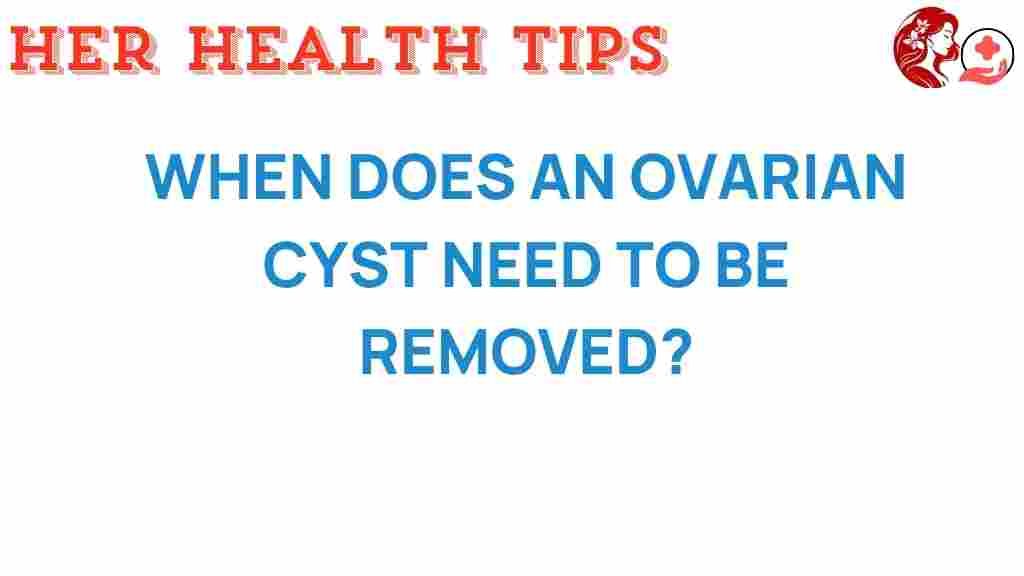Unraveling Ovarian Cysts: When Is Surgical Removal Necessary?
Ovarian cysts are fluid-filled sacs that form on or inside the ovaries and are a common concern in women’s health. While most ovarian cysts are harmless and often resolve on their own, there are instances where they can cause significant health issues, leading to the necessity for surgical removal. Understanding ovarian cysts, their symptoms, diagnosis, and treatment options is crucial for maintaining optimal health. This article will explore when surgical removal of ovarian cysts is necessary and provide insights into preventive care and management.
What Are Ovarian Cysts?
Ovarian cysts are typically categorized into two main types:
- Functional Cysts: These are the most common type and usually develop during the menstrual cycle. They include follicular cysts and corpus luteum cysts, which often resolve on their own.
- Pathological Cysts: These are less common and may be filled with tissue or abnormal cells. They can include dermoid cysts, endometriomas, and cystadenomas.
Understanding the type of cyst is essential for determining the appropriate treatment and whether surgical removal is necessary.
Symptoms of Ovarian Cysts
Many women with ovarian cysts experience no symptoms at all. However, when symptoms do occur, they can include:
- Pelvic pain or discomfort
- Menstrual irregularities
- Abdominal bloating or swelling
- Pain during intercourse
- Difficulty emptying the bladder or bowel
- Nausea or vomiting
If you experience severe pain or sudden symptoms, it’s essential to seek medical attention promptly, as these could indicate a ruptured cyst or other complications.
Diagnosis of Ovarian Cysts
The diagnosis of ovarian cysts typically involves a combination of a physical examination, medical history review, and imaging tests. Common diagnostic methods include:
- Pelvic Exam: A healthcare provider checks for any abnormalities in the ovaries.
- Ultrasound: This imaging test uses sound waves to create an image of the ovaries, helping to determine the size and type of cyst.
- CT or MRI Scans: These may be used in certain cases to provide more detailed images.
- Blood Tests: To check hormone levels and rule out other conditions.
When Is Surgical Removal Necessary?
While most ovarian cysts are benign and can be managed with monitoring, there are specific instances where surgical removal becomes necessary:
- Large Cysts: Cysts larger than 5-10 centimeters may require removal to prevent complications.
- Persistent Cysts: If a cyst does not resolve after several menstrual cycles, surgery may be indicated.
- Symptomatic Cysts: Cysts causing significant pain or discomfort may need to be surgically removed.
- Ruptured Cysts: If a cyst ruptures, it can lead to internal bleeding and requires immediate surgical intervention.
- Suspicion of Cancer: If there is a concern that a cyst may be cancerous, surgical exploration and removal are critical for diagnosis and treatment.
Types of Surgical Procedures
There are two primary surgical procedures for removing ovarian cysts:
- Laparoscopy: A minimally invasive procedure where small incisions are made, and a camera is used to guide the removal of the cyst. This method usually results in less pain and a quicker recovery.
- Laparotomy: A more invasive surgery involving a larger incision. This is typically reserved for larger cysts or when cancer is suspected.
During the consultation, your gynecologist will discuss the most appropriate option based on your specific situation.
Post-Surgical Care
After undergoing surgical removal of ovarian cysts, proper post-operative care is crucial for recovery. Here are some tips for a smooth healing process:
- Follow your doctor’s instructions regarding medication and wound care.
- Monitor for any signs of infection, such as fever, increased pain, or unusual discharge.
- Limit physical activity as advised, especially heavy lifting or strenuous exercise.
- Attend follow-up appointments to monitor healing and discuss any further treatment if necessary.
Preventive Care for Ovarian Cysts
While not all ovarian cysts can be prevented, certain lifestyle choices can help reduce the risk:
- Regular Check-ups: Routine gynecological exams can help in early detection and management of ovarian cysts.
- Hormonal Birth Control: Using contraceptives can prevent ovulation and reduce the likelihood of functional cysts.
- Healthy Diet and Exercise: Maintaining a balanced diet and regular physical activity can enhance overall reproductive health.
Conclusion
Ovarian cysts are a common aspect of women’s health, and while they often pose no serious health threat, understanding when surgical removal is necessary is vital. By recognizing the symptoms, seeking proper diagnosis, and discussing treatment options with a healthcare provider, women can take charge of their health. Preventive care and regular check-ups play key roles in managing ovarian cysts effectively.
If you’re experiencing symptoms of ovarian cysts or have concerns about your gynecological health, don’t hesitate to reach out to a healthcare professional. For more information on women’s health issues, visit this resource. Remember, taking care of your health is the first step towards a better quality of life.
For additional insights into gynecology and women’s health, feel free to explore our previous articles here.
This article is in the category Reproductive and created by HerHealthTips Team
